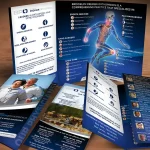In today’s digital age, having a strong online presence is crucial for businesses of all sizes. One of the key components of a successful online presence is a well-designed website. A website serves as the virtual storefront for your business, and it is often the first impression that potential customers have of your brand. Therefore, it is essential to invest in professional web design to ensure that your website accurately represents your brand and effectively engages your target audience.
The purpose of this blog post is to highlight the importance of hiring a top web design company and provide insights into the web design process. We will discuss the benefits of hiring professionals, understanding your business needs and goals, the latest trends in web design, choosing the right web design company, creating a user-centered design, optimizing your website for search engines, integrating social media and other digital marketing strategies, and measuring the success of your web design.
Key Takeaways
- Web design is important in today’s digital age for creating a strong online presence.
- Hiring a top web design company can provide numerous benefits for your business.
- Understanding your business needs and goals is crucial for effective web design.
- Keeping up with the latest web design trends can benefit your business.
- Choosing the right web design company involves considering factors such as experience and portfolio.
The Benefits of Hiring a Top Web Design Company
Hiring a top web design company offers numerous advantages for businesses. Firstly, professionals have the expertise and experience to create visually appealing and functional websites that align with your brand identity. They understand the latest design trends and can incorporate them into your website to make it stand out from competitors.
Additionally, professional web designers have a deep understanding of user experience (UX) design principles. They know how to create intuitive navigation, clear calls-to-action, and engaging content that keeps visitors on your site longer. This can lead to increased conversions and ultimately drive more sales for your business.
Furthermore, hiring a top web design company saves you time and resources. Instead of trying to build a website yourself or relying on an inexperienced designer, professionals can efficiently create a high-quality website that meets your specific needs. This allows you to focus on other aspects of your business while leaving the web design process in capable hands.
Understanding Your Business Needs and Goals
Before embarking on the web design process, it is crucial to understand your business needs and goals. This will ensure that your website effectively represents your brand and serves its intended purpose. To identify your business needs and goals, consider the following tips:
1. Define your target audience: Understanding who your target audience is will help you tailor your website design to their preferences and needs. Conduct market research to gain insights into their demographics, interests, and online behavior.
2. Determine your website’s purpose: What do you want your website to achieve? Is it primarily an e-commerce platform, a lead generation tool, or an informational resource? Clearly defining the purpose of your website will guide the design process and help you prioritize its features and functionalities.
3. Set measurable goals: Establish specific, measurable goals for your website. For example, you may aim to increase online sales by a certain percentage or generate a certain number of leads per month. Having measurable goals allows you to track the success of your web design efforts and make data-driven decisions.
The Latest Trends in Web Design
Web design trends are constantly evolving as technology advances and user preferences change. Staying up-to-date with the latest trends can give your website a modern and fresh look, as well as improve user experience. Some of the latest trends in web design include:
1. Minimalistic design: Minimalism focuses on simplicity and clean aesthetics. It involves using ample white space, simple typography, and minimal use of colors and graphics. This trend creates a visually appealing and clutter-free website that allows users to focus on the content.
2. Mobile-first design: With the increasing use of smartphones and tablets, it is essential to have a mobile-friendly website. Mobile-first design involves designing for mobile devices first and then adapting the layout for larger screens. This ensures that your website looks great and functions well on all devices.
3. Microinteractions: Microinteractions are small animations or visual cues that provide feedback to users when they interact with a website. For example, a button changing color when hovered over or a loading spinner indicating that a process is in progress. These subtle interactions enhance user engagement and make the website more interactive.
4. Dark mode: Dark mode is a design trend that involves using dark backgrounds with light-colored text and elements. It not only looks sleek and modern but also reduces eye strain, especially in low-light environments. Dark mode is particularly popular among users who spend a lot of time on their devices.
By incorporating these trends into your web design, you can create a visually appealing and user-friendly website that stands out from the competition.
Choosing the Right Web Design Company
Choosing the right web design company is crucial for the success of your website. Here are some factors to consider when making your decision:
1. Portfolio and experience: Review the web design company’s portfolio to see examples of their previous work. Look for websites that are visually appealing, functional, and align with your aesthetic preferences. Additionally, consider the company’s experience in your industry or niche.
2. Client testimonials and reviews: Read client testimonials and reviews to get an idea of the company’s reputation and customer satisfaction. Positive feedback from previous clients is a good indicator of the company’s professionalism and quality of work.
3. Communication and collaboration: Effective communication is essential throughout the web design process. Choose a company that is responsive, listens to your needs, and communicates clearly. Collaboration is also important, as you will be working closely with the web design team to bring your vision to life.
4. Pricing and budget: Consider your budget and compare pricing among different web design companies. Keep in mind that quality web design is an investment, so prioritize value over cost. Look for companies that offer transparent pricing and provide detailed quotes.
The Web Design Process
The web design process typically consists of several steps, from conceptualization to launch. Here is an overview of each step:
1. Discovery and research: This initial phase involves gathering information about your business, target audience, and competitors. The web design company will conduct research to understand your industry and identify opportunities for differentiation.
2. Planning and strategy: In this phase, the web design company will create a plan and strategy for your website. This includes defining the site structure, creating wireframes or mockups, and outlining the content and features.
3. Design and development: Once the planning phase is complete, the web design company will start designing and developing your website. This involves creating the visual design, coding the website, and integrating any necessary functionalities.
4. Content creation: Content is a crucial component of any website. The web design company may assist with content creation, including writing copy, sourcing images, and optimizing content for search engines.
5. Testing and quality assurance: Before launching your website, it is important to thoroughly test its functionality and performance. The web design company will conduct testing to ensure that all features work as intended and that the website is compatible with different devices and browsers.
6. Launch and optimization: Once testing is complete, your website will be launched. The web design company will assist with the launch process and provide ongoing support for any necessary optimizations or updates.
Creating a User-Centered Design
Creating a user-centered design is essential for providing a positive user experience on your website. Here are some tips for designing a user-centered website:
1. Conduct user research: Gain insights into your target audience’s preferences, needs, and behaviors through user research. This can involve surveys, interviews, or usability testing. Use this information to inform your design decisions.
2. Prioritize usability: Make sure your website is easy to navigate and intuitive to use. Use clear labels, logical page hierarchy, and consistent navigation menus to guide users through your site. Avoid cluttered layouts and excessive use of animations or effects that may distract or confuse users.
3. Optimize page load times: Slow-loading websites can lead to high bounce rates and frustrated users. Optimize your website’s performance by minimizing file sizes, leveraging caching techniques, and using a content delivery network (CDN) to deliver content faster.
4. Use responsive design: With the increasing use of mobile devices, it is crucial to have a responsive website that adapts to different screen sizes. Responsive design ensures that your website looks and functions well on all devices, providing a seamless user experience.
5. Incorporate user feedback: Regularly gather feedback from users and make improvements based on their suggestions. This can be done through surveys, feedback forms, or user testing sessions. By incorporating user feedback, you can continuously improve your website’s usability and meet the needs of your target audience.
Optimizing Your Website for Search Engines
Optimizing your website for search engines is essential for improving its visibility in search engine results pages (SERPs). Here are some tips for optimizing your website:
1. Conduct keyword research: Identify relevant keywords and phrases that your target audience is likely to search for. Use keyword research tools to find high-volume, low-competition keywords that you can incorporate into your website’s content.
2. Optimize on-page elements: Optimize on-page elements such as page titles, meta descriptions, headings, and image alt tags with relevant keywords. This helps search engines understand the content of your pages and improves their visibility in search results.
3. Create high-quality content: Publish informative and engaging content that provides value to your target audience. Use keywords naturally throughout your content and include relevant internal and external links to enhance its SEO value.
4. Build high-quality backlinks: Backlinks from reputable websites are an important ranking factor for search engines. Focus on building high-quality backlinks through guest blogging, influencer outreach, and content promotion. This can help improve your website’s authority and visibility in search results.
5. Monitor and analyze your SEO efforts: Regularly monitor your website’s performance in search results using tools like Google Analytics and Google Search Console. Track your keyword rankings, organic traffic, and other relevant metrics to measure the success of your SEO efforts. Use this data to make informed decisions and optimize your website further.
Integrating Social Media and Other Digital Marketing Strategies
Integrating social media and other digital marketing strategies into your web design can help improve your online presence and drive more traffic to your website. Here are some tips for using social media and other digital marketing strategies effectively:
1. Social media integration: Incorporate social media sharing buttons on your website to encourage visitors to share your content on their social networks. This can help increase brand visibility and drive more traffic to your website. Additionally, display social media feeds or icons on your website to promote your social media profiles.
2. Content marketing: Create valuable and shareable content that aligns with your target audience’s interests. Publish blog posts, videos, infographics, or other types of content that provide value and establish your brand as an industry authority. Promote this content through social media, email marketing, and other channels to attract more visitors to your website.
3. Email marketing: Build an email list of interested prospects and customers and send them regular newsletters or updates. Use email marketing to nurture leads, promote new products or services, and drive traffic back to your website.
4. Pay-per-click (PPC) advertising: Consider running PPC advertising campaigns on platforms like Google Ads or social media platforms to drive targeted traffic to your website. Set a budget, define your target audience, and create compelling ad copy that encourages users to click through to your website.
5. Search engine marketing (SEM): SEM involves optimizing your website for search engines (SEO) and running paid search advertising campaigns (PPC). By combining SEO and PPC, you can increase your website’s visibility in search results and drive more targeted traffic.
By integrating these digital marketing strategies into your web design, you can effectively promote your brand, attract more visitors to your website, and ultimately drive more conversions.
Measuring the Success of Your Web Design
Measuring the success of your web design is essential for making data-driven decisions and continuously improving your website’s performance. Here are some metrics and analytics to track:
1. Website traffic: Monitor the number of visitors to your website over time. Track the total number of sessions, unique visitors, and pageviews to understand how your website is performing.
2. Conversion rate: Measure the percentage of visitors who take a desired action on your website, such as making a purchase or filling out a contact form. Calculate your conversion rate by dividing the number of conversions by the number of total visitors and multiplying by 100.
3. Bounce rate: Bounce rate refers to the percentage of visitors who leave your website after viewing only one page. A high bounce rate may indicate that your website is not engaging or relevant to visitors. Aim for a low bounce rate by improving your website’s design, content, and user experience.
4. Average session duration: Average session duration measures how long visitors spend on your website on average. A longer average session duration indicates that visitors are engaged with your content and finding value in it.
5. Goal completions: Set up goals in Google Analytics to track specific actions that you want visitors to take on your website, such as signing up for a newsletter or making a purchase. Monitor the number of goal completions to measure the success of your web design in driving conversions.
In today’s digital age, effective web design is crucial for businesses looking to establish a strong online presence. Hiring a top web design company offers numerous benefits, including professional expertise, improved user experience, and time and resource savings. Understanding your business needs and goals is essential for creating a website that accurately represents your brand and serves its intended purpose.
Staying up-to-date with the latest trends in web design can give your website a modern and fresh look, as well as improve user experience. Choosing the right web design company involves considering factors such as portfolio, experience, communication, and pricing. The web design process typically consists of several steps, from discovery and research to launch and optimization.
Creating a user-centered design is essential for providing a positive user experience on your website. Optimizing your website for search engines improves its visibility in search results and drives more organic traffic. Integrating social media and other digital marketing strategies into your web design can help improve your online presence and attract more visitors to your website. Finally, measuring the success of your web design through analytics and metrics allows you to make data-driven decisions and continuously improve your website’s performance.
In conclusion, effective web design is a critical component of a successful online presence. By investing in professional web design and following best practices, businesses can create visually appealing, user-friendly websites that engage their target audience and drive conversions.
If you’re looking for a web design company that can create stunning websites tailored to your business needs, look no further than Bracha Designs. With their expertise in website design, they have helped numerous clients in Bohemia and Ronkonkoma achieve their online goals. In fact, they recently published an article on their website discussing the differences between SEO and PPC, two essential strategies for driving traffic to your website. To learn more about how these strategies can benefit your business, check out their article here.
FAQs
What is a web design company?
A web design company is a business that specializes in creating and designing websites for clients. They typically offer services such as website design, development, maintenance, and optimization.
What services do web design companies offer?
Web design companies offer a range of services including website design, development, maintenance, and optimization. They may also offer services such as website hosting, content creation, and digital marketing.
Why should I hire a web design company?
Hiring a web design company can ensure that your website is professionally designed, user-friendly, and optimized for search engines. They can also save you time and effort by handling the technical aspects of website design and maintenance.
How do I choose a web design company?
When choosing a web design company, consider factors such as their experience, portfolio, pricing, and customer reviews. It’s also important to ensure that they have the necessary skills and expertise to meet your specific website design needs.
How much does it cost to hire a web design company?
The cost of hiring a web design company can vary depending on factors such as the complexity of the website, the services required, and the experience of the company. It’s important to get a detailed quote and understand the pricing structure before hiring a web design company.
What is the process of working with a web design company?
The process of working with a web design company typically involves an initial consultation to discuss your website design needs and goals. The company will then create a design proposal and work with you to refine the design. Once the design is finalized, the company will develop and launch the website, and provide ongoing maintenance and optimization services.















0 Comments